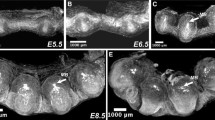Abstract.
Magnetic resonance microscopy, a non-invasive imaging technique was used for a longitudinal follow-up of mouse embryonic development in utero and for the assessment of embryonic kidney function using 50 nm magnetite dextran particles. Even though the morphologic proton images obtained were still far from classical histological slices quality, an in-plan resolution of 195 µm was achieved for a slice thickness of 800 µm. Mouse embryos sub-structures such as the fourth ventricle, the mesencephalic vesicle, the aorta or the liver can be revealed as early as E11/12. Heart, diaphragm, spinal cord, third, fourth and lateral ventricles were unambiguously seen at E13/14; whereas skeleton, tail, kidney and digit can only be seen from E15/16. Kidney and bladder were certainly identified from E16 on. MR microscopy offers a possibility for in utero phenotyping of mice and can therefore be a powerful tool for post-genomic applications.
Similar content being viewed by others
Author information
Authors and Affiliations
Additional information
Electronic Publication
Rights and permissions
About this article
Cite this article
Chapon, .C., Franconi, .F., Roux, .J. et al. In utero time-course assessment of mouse embryo development using high resolution magnetic resonance imaging. Anat Embryol 206, 131–137 (2002). https://doi.org/10.1007/s00429-002-0281-6
Accepted:
Issue Date:
DOI: https://doi.org/10.1007/s00429-002-0281-6




